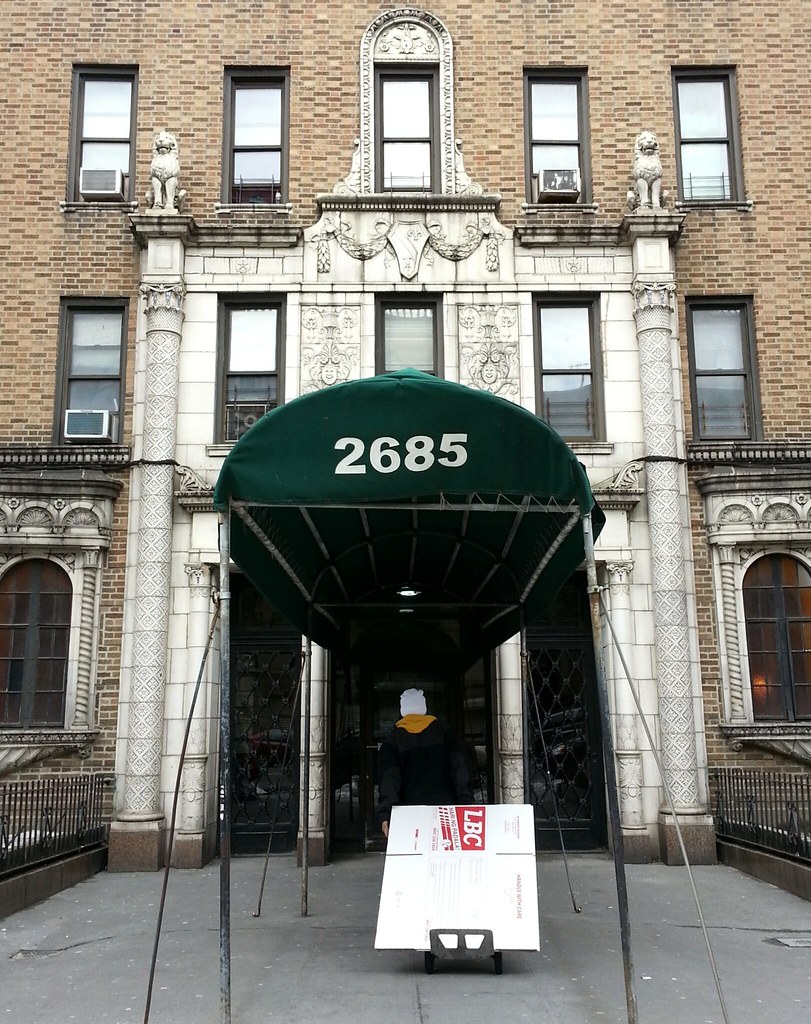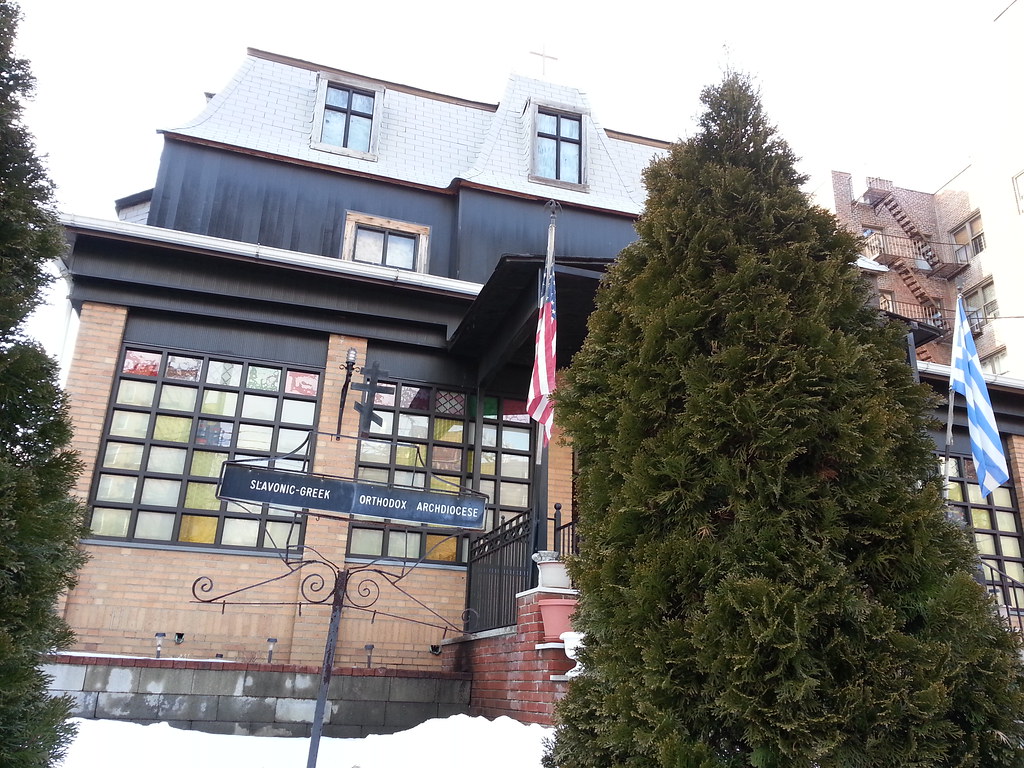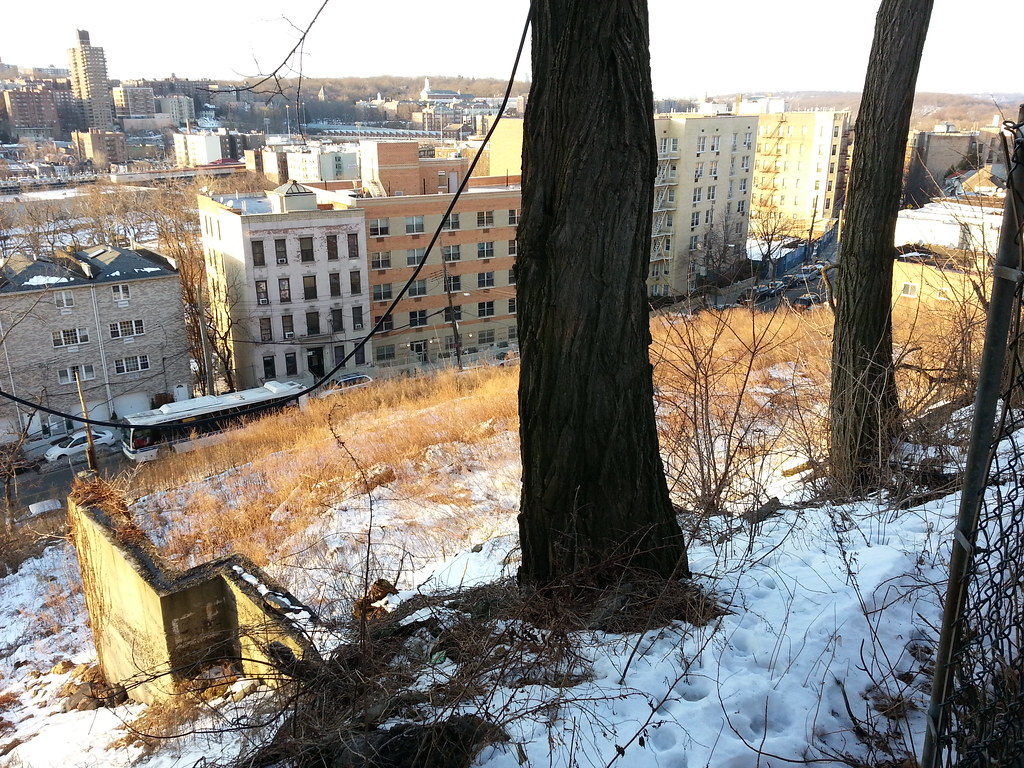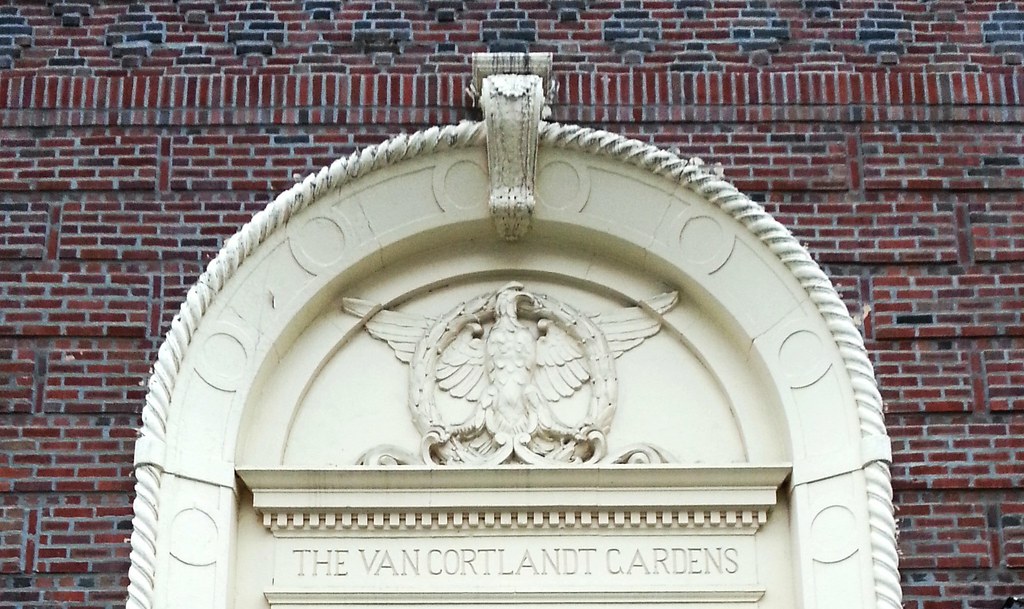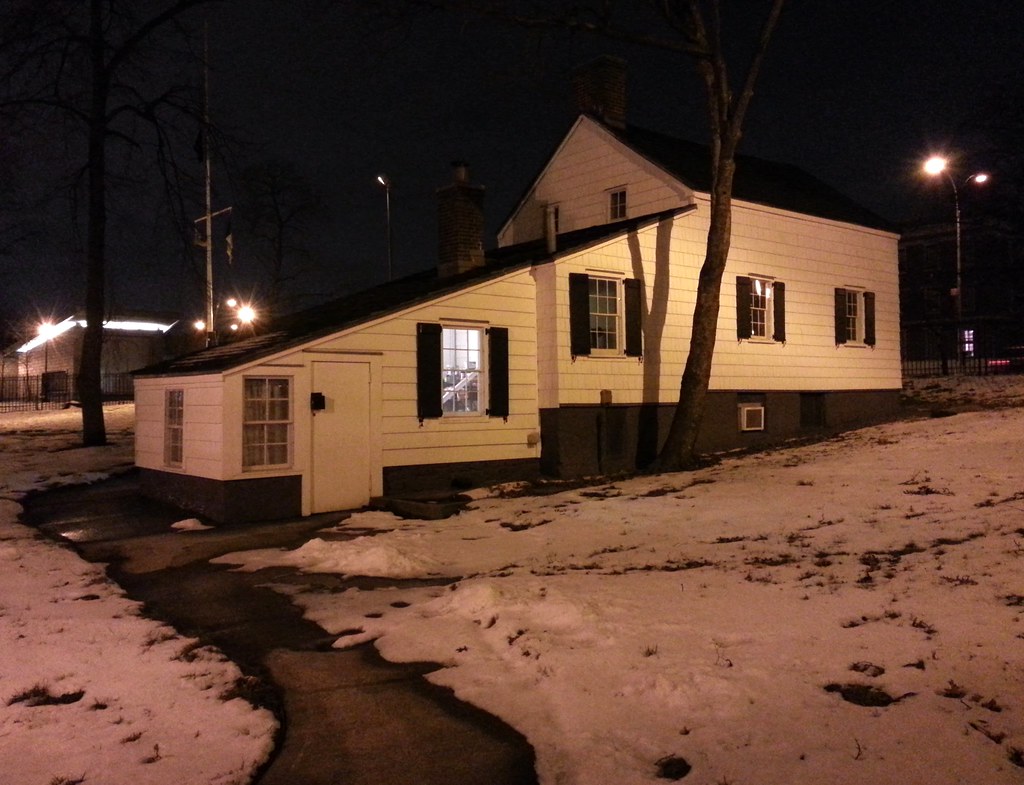
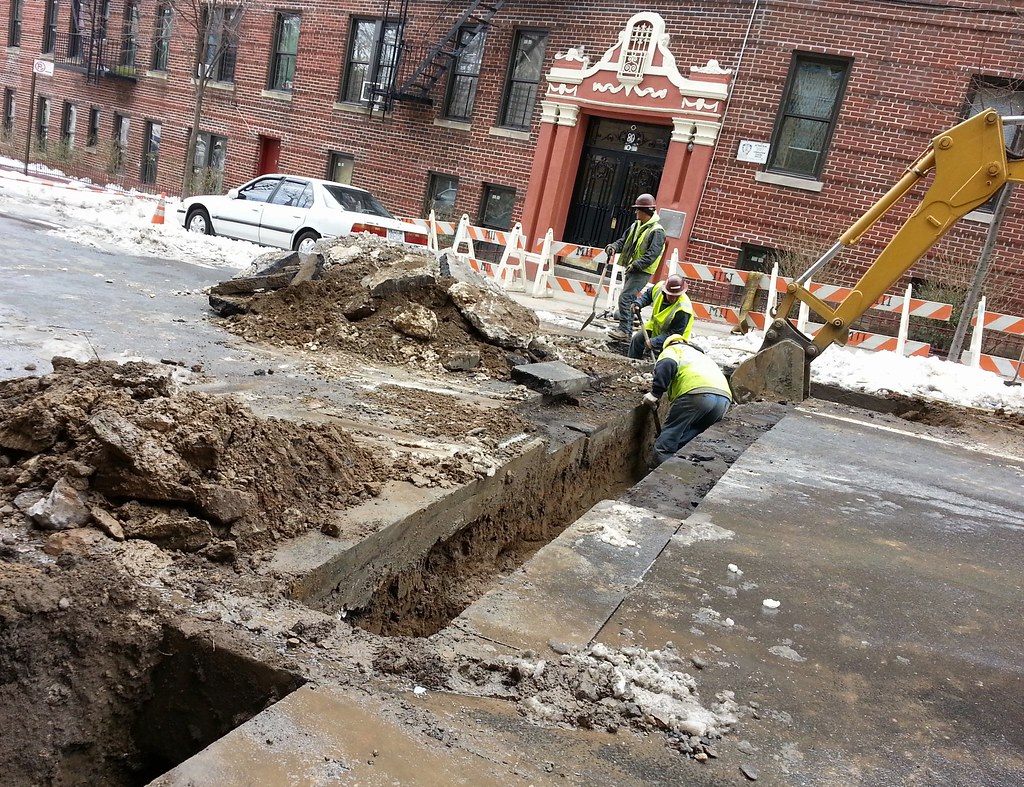
The gutter was left in place to keep water flowing across the cut in the road. Zoom in to see it in action.

Upon this hill stood Fort Number Four, built by the Americans in 1776 and later captured and occupied by the British during the Revolutionary War. The remains of the redoubt were discovered by the amateur archaeologist Reginald Pelham Bolton (the same guy who reconstructed the Hessian hut on the grounds of the Dyckman Farmhouse) sometime around 1910. After being designated as parkland, the site of the old fort was "released from brambles and suitably marked" with this plaque, which was unveiled in 1914 "with appropriate ceremonies".

The former site of Fort Number Four now offers a nice view of the Jerome Park Reservoir.
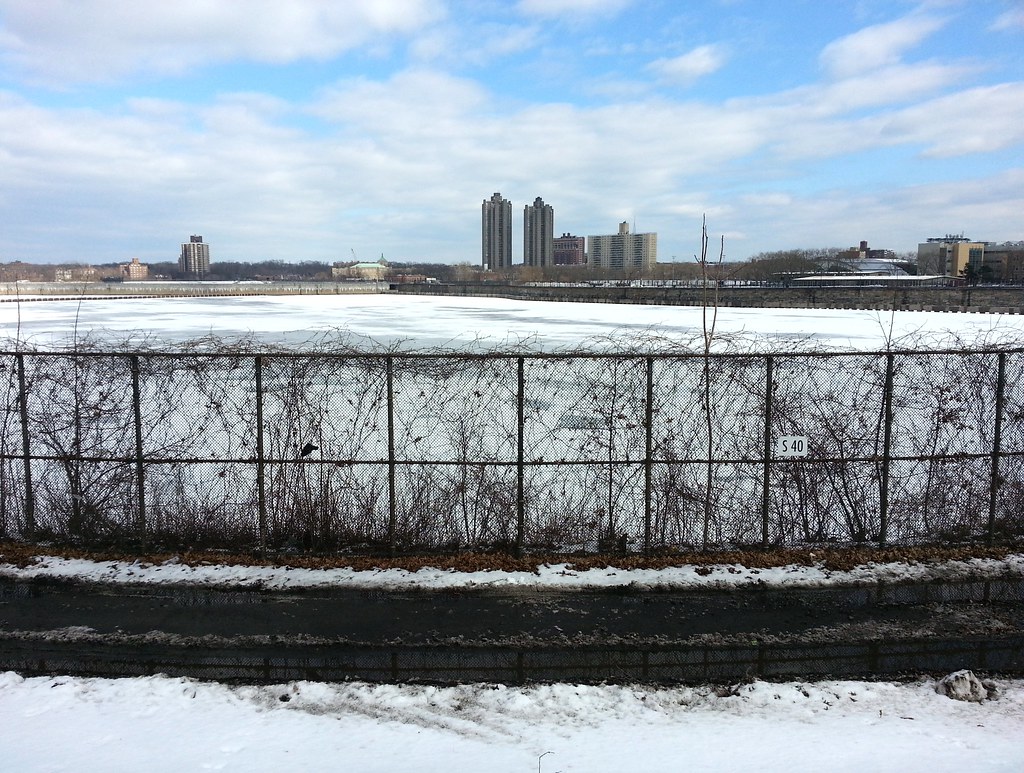
with the Bronx's tallest buildings looming in the distance

Converted into the Kingsbridge Heights Community Center in 1974-75 by three dedicated women, this building was originally the station house of the NYPD's 50th Precinct. (Actually, it was originally the station house of the 40th Precinct, which later became the 74th, then the 57th, then the 26th, and finally, on August 1st, 1929, the 50th Precinct.)
In the late 1800s, this precinct (then the 35th — isn't this fun?) was headquartered in a dilapidated "shanty"; it was said by one reporter that "no more unhealthier police station exists in the City of New York than this one". An 1898 review by The Real Estate Record and Guide "branded municipal architecture a disgrace" and claimed that "there is not even one architecturally decent police station" in the entire city.
Things were soon to take a turn for the better, however. The city began a campaign to improve its police facilities, and the burgeoning City Beautiful movement was redefining the nature of New York's civic architecture.
The 50th Precinct house was erected in 1901-02, and it's quite an impressive edifice, at least to the eye of this 21st-century pedestrian. At the time of its construction, however, its architects, Arthur Horgan and Vincent Slattery, were widely reviled, seen as talentless nobodies who received commission after commission from Mayor Robert Van Wyck because of their ties to Tammany Hall.
In addition to their design work, Horgan and Slattery were often hired by Van Wyck to consult on the plans of much more respected architects, giving some the impression that their real role was to ensure that the projects were funneling a sufficient amount of money into the pockets of Tammany contractors. In 1899, the NY Times had this to say about the duo, whom few had heard of prior to Van Wyck taking office the year before:
Who are, or what is, "Horgan and Slattery"? . . . Whenever there is a decent and considerate project of architecture involved, Horgan and Slattery are invoked to give the weight of their professional opinion to the proposition that it is "no good."After the municipal reformer Seth Low was elected mayor in 1901, he called for the "dishorganizing and unslatterifying" of city architecture, and sought, with only partial success, to cancel the city's outstanding contracts with the firm. Much to his chagrin, Horgan and Slattery were able to hold on to their highest-profile job, the completion of the Hall of Records (known today as the Surrogate's Courthouse). The mayor supposedly then took another tack, using his influence to throw wrench after wrench into the firm's plans for the Hall. His administration's Art Commission, for example, was known to have repeatedly rejected the proposals of the sculptors that had been hired for the job.
But, then, is their professional opinion any good? Has it any weight? Does anybody know who they are or what they have done or why any human being should pay them a nickel each for their opinions on the art of architecture or even whether they exist? It is of course possible that there are two actual, concrete human beings who call themselves respectively Horgan and Slattery, and who call themselves artchitects. . . .
[But] suppose that, for its own purposes, Tammany had invented an architectural firm which had no corporeal or personal existence, and called it, let us say, Organ and Flattery, and had used it to "hold up" every public building on which the "divvy" was not satisfactory to the organization! What would be the difference? Would not Organ command as large a degree of the public confidence as Horgan, and Flattery as Slattery?
Frustrated by all the setbacks, Horgan and Slattery reportedly came up with a plan to embarrass the Art Commission, which they suspected was blindly shooting down their designs. They had their sculptors submit a new set of plans for the Hall of Records that just happened to consist of careful copies of work by Michelangelo and Leonardo da Vinci — which was then, of course, rejected by the unknowing commissioners. Or, as Slattery himself put it:
It was arranged to submit to the Municipal Art Commission exact reproductions for the cornices of some gargoyles by Michelangelo in St. Peter's at Rome. Many of these drawings were rejected by the Municipal Art Commission as not being up to the standard of their artistic ideas. I won't say much more about the matter just now.Removed from the political acrimony of the time, today's architectural critics seem to have more favorable opinions of Horgan and Slattery. The AIA Guide to New York City calls the 50th Precinct house "a rich Renaissance Revival-Eclectic building", and the Times's Christopher Gray writes that "their work rises far above the hack category into which it is . . . often dumped."
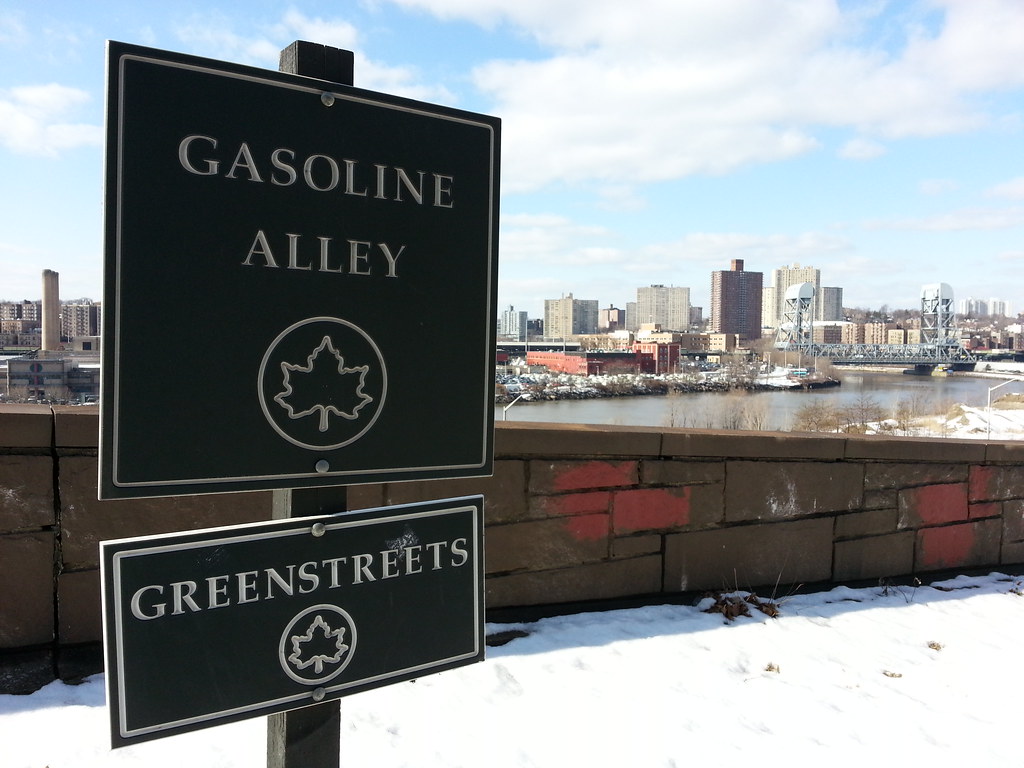
When I first passed this snowy strip two days ago, I somehow failed to notice this sign indicating it is one of the city's most intriguingly named parks. Unfortunately, I can't find any information about the origin of its appellation online. The name is probably a reference to the nearby Major Deegan Expressway (located just on the other side of that brown retaining wall), but I like to imagine it has something to do with those mystery garages located across the street.
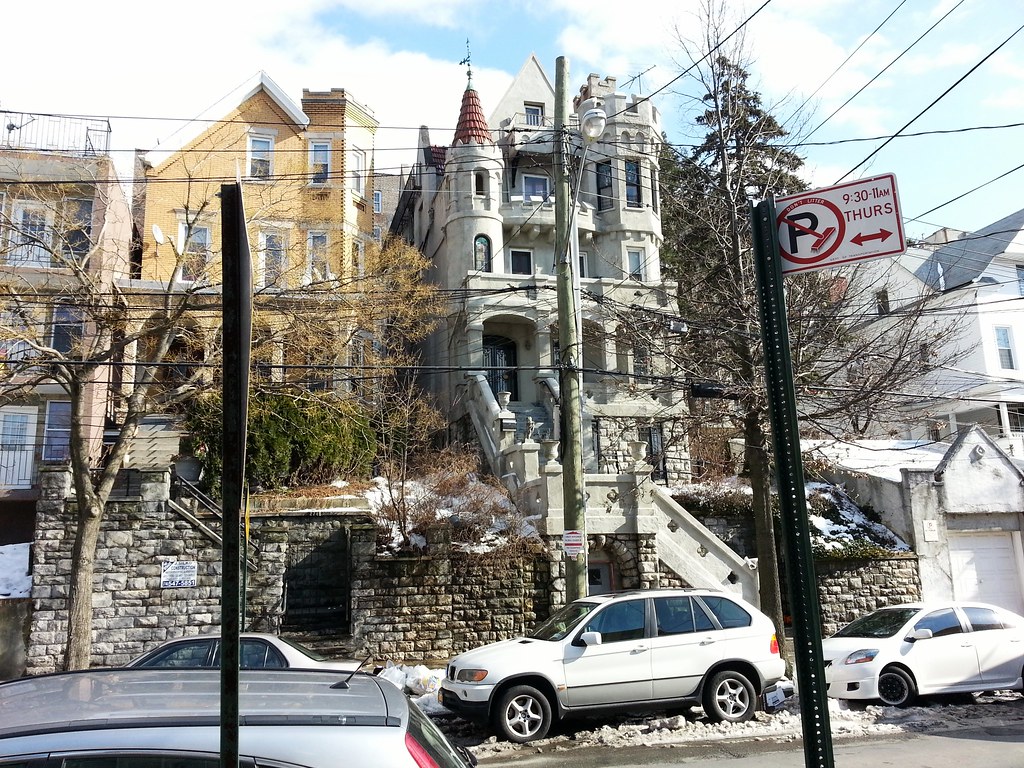
Kevin Walsh of Forgotten New York reports:
This castle redoubt at 2744 Kingsbridge Terrace guarded the realm against invading Riverdalians and the despised Norwooders. Boiling chicken fat was poured through the quatrefoil'd buttresses at any invader who chanced to mount a frontal assault. The castle was erected in 1914.
The AIA Guide to NYC weighs in: Close by the vast veterans' hospital [at 130 W. Kingsbridge Road] is this tiny monument, a stucco castle with numerous gables, balconies, crenellated turrets, a weathervane, a TV antenna, and a tunnel reputedly leading from the "dungeon" to the street.
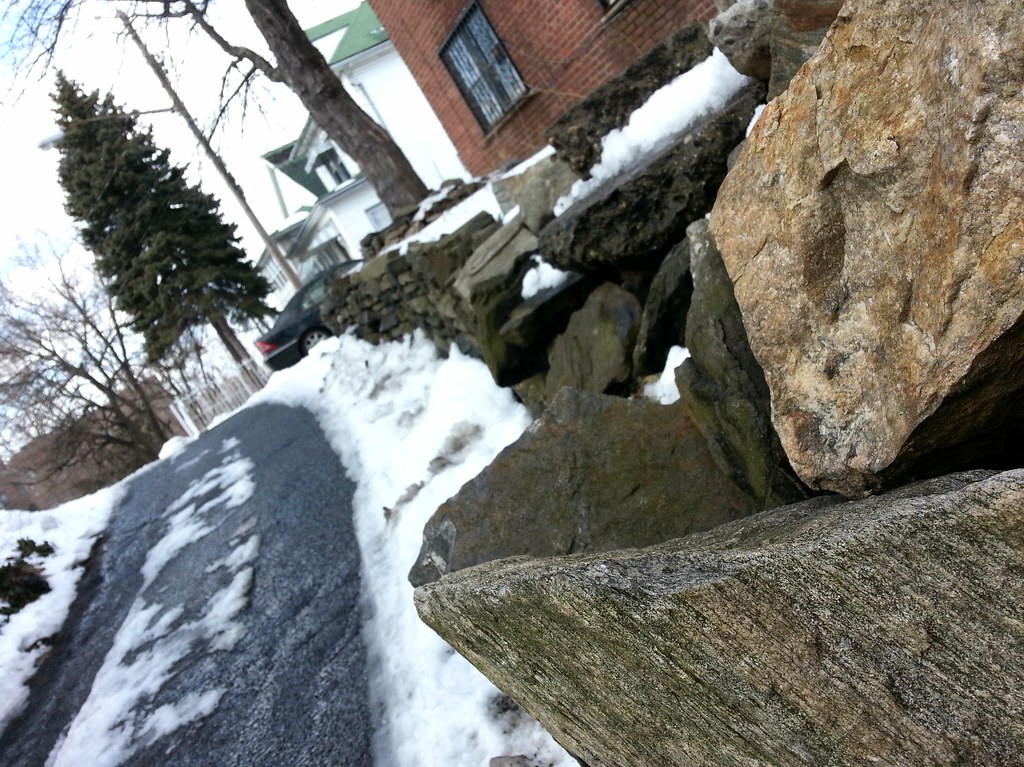
This little dead-end lane does not have curbside garbage pickup, so its residents have to haul their refuse down to Kingsbridge Terrace for collection. A woman who lives on Kingsbridge Terrace right next to Shrady Place (in that red brick house, in fact) told me she had to put up this sign because she kept getting fined by the Department of Sanitation for the sidewalk obstruction caused by all the garbage.
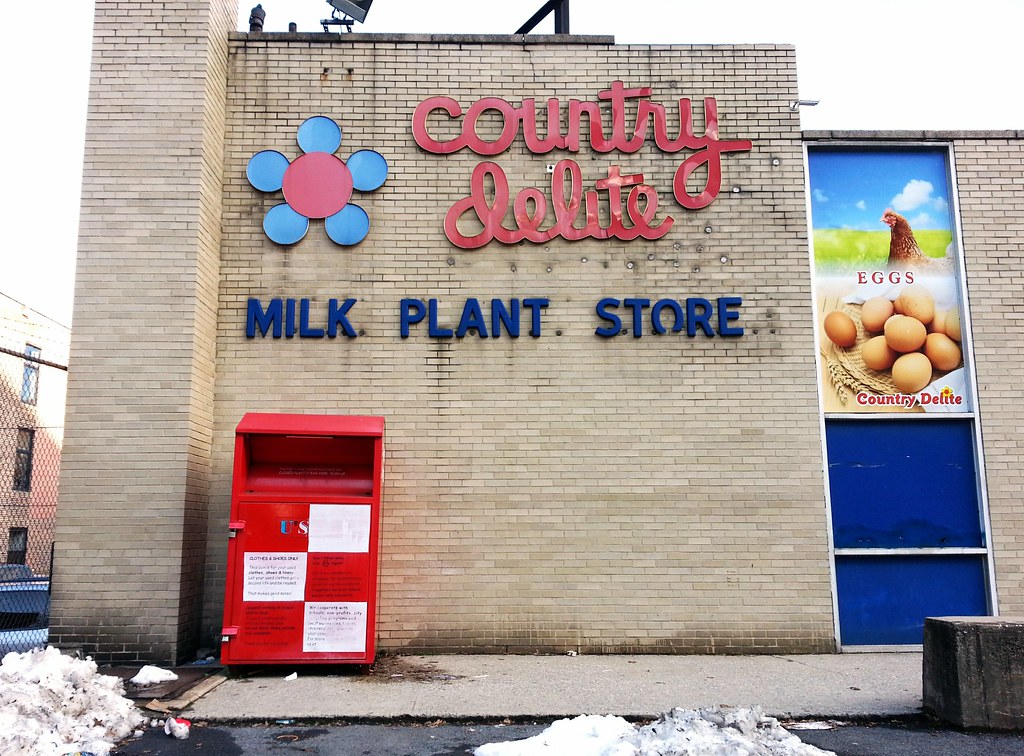
From a 1986 New York Magazine article (be sure to notice the ad featuring Leona Hemsley — one of four on consecutive odd-numbered pages in the issue) about places in the city to take large groups of children for birthday parties and the like:
From behind a glass partition in the Country Delite Milk Plant Store near 230th Street and Broadway in the Bronx, children can watch milk being pumped through pipes into stainless-steel vats, sent from a filtering system to a clarifier and then to a homogenizer, and, finally, poured into plastic containers. Children can spend anywhere from five minutes to half an hour here, and the manager, Mr. Kleinman, is particularly friendly and eager to answer questions.

I wonder how many members there are; the entire island of Kasos (satellite view) only has about 1000 residents.
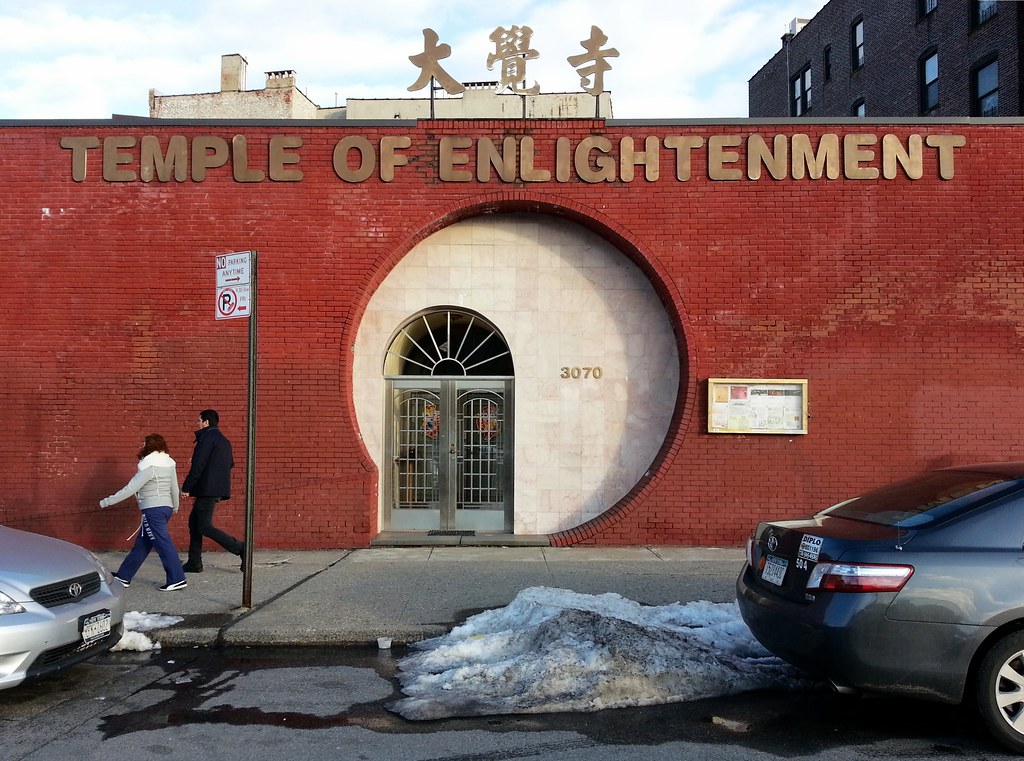
This Buddhist temple is housed in an old telephone company office.
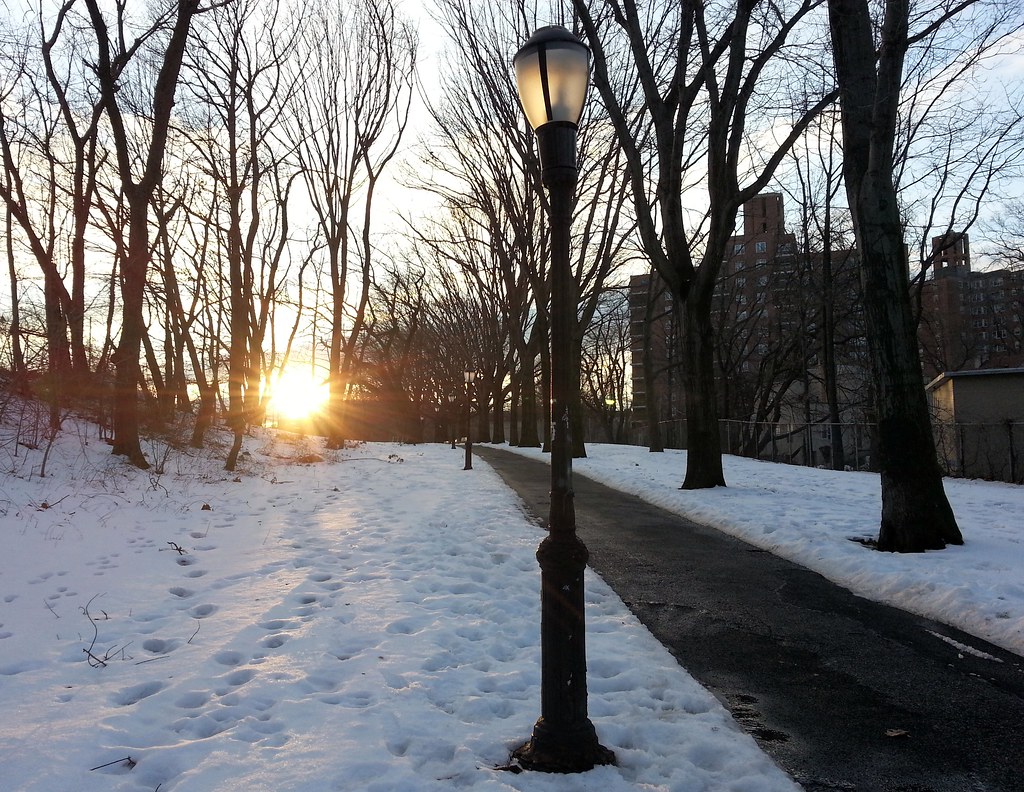
We've been by this park before. What I didn't know at the time is that its creation (page 9) followed a rather sizeable discovery of Revolutionary War relics in the neighborhood by a group of unlikely archaeologists. As our friend Reginald Pelham Bolton tells it:
One day in May, 1915, a party of boys led by Bradshaw Thurston, James Knowles, H.G. Somers, and others, resident in the vicinity, were fired with the idea of mimic warfare, and were engaged in constructing a small trench, at the head of Cannon Place, to the east of the site of Fort Independence, when their spades disturbed a cannon ball, soon succeeded by a number of other shot, until their work led them into a mass of about five hundred solid and hollow shot and bombs buried below the soil in a tangled and rusted heap. . . .
The deposit evidently consisted of materials hastily abandoned by the Pennsylvania Regiment, commanded by Colonel John Lasher, who on October 27, 1776, on receipt of orders from General Washington, destroyed the barracks and abandoned the fort and its equipment, in advance of the arrival of the Hessian army moving in from Westchester county, against Fort Washington and its exterior defenses.
The location of the find in the rear of the effort seems to indicate that the shots were thrown under some building or tumbled into a cess-pit, and were thereafter undiscovered by the Hessian and British occupants of the fort.

